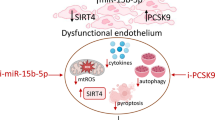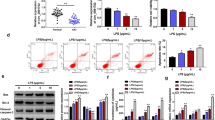Abstract
This study aims to investigate the effects of miR-29b-3p on the inflammation injury of human umbilical vein endothelial cells (HUVECs) induced by lipopolysaccharide (LPS) and explore the underlying mechanisms. The effects of different concentrations of LPS (0, 1, 5 and 10 μg/mL) on inflammation injury in HUVECs are detected by ELISA, CCK-8, EdU, flow cytometry and western blot analyses to determine the optimal stimulus concentration. After stimulating HUVECs with 10 μg/mL LPS, the expression levels of miR-29b-3p are detected, and the effects of miR-29b-3p on inflammation injury are detected by ELISA, CCK-8, EdU, flow cytometry and western blot analyses. Bioinformatic analysis, luciferase reporter assay and confirmatory experiments are applied to identify the target gene bound with miR-29b-3p. Rescue experiments have verified the roles of miR-29b-3p and the target gene in inflammation injury. We found that pro-inflammatory factor was increased, apoptosis was promoted, and cell proliferation was inhibited after the treatment of LPS in HUVECs. Overexpression of miR-29b-3p inhibited LPS-induced inflammatory response and apoptosis while promoting proliferation in HUVECs. Besides, bioinformatics analysis indicated that SEC23A was the target gene of miR-29b-3p and the confirmatory experiments showed that SEC23A was negatively correlated with miR-29b-3p and positively correlated with LPS concentration. Rescue experiments revealed that overexpression of SEC23A partially enhanced the inflammation injury effects in LPS-induced HUVECs with overexpression of miR-29b-3p. Hence, miR-29b-3p repressed inflammatory response, cell apoptosis and promoted cell proliferation in LPS-induced HUVECs by targeting SEC23A, providing a potential target for treating sepsis.







Similar content being viewed by others
Availability of Data and Material
All data generated or analysed during this study are included in this published article.
References
Bermejo-Martin JF, Martín-Fernandez M, López-Mestanza C et al (2018) Shared features of endothelial dysfunction between sepsis and its preceding risk factors (aging and chronic disease). J Clin Med 7(11):400
Cecconi M, Evans L, Levy M et al (2018) Sepsis and septic shock. Lancet 392(10141):75–87
Cui J, Li Z, Zhuang S et al (2018) Melatonin alleviates inflammation-induced apoptosis in human umbilical vein endothelial cells via suppression of Ca(2+)-XO-ROS-Drp1-mitochondrial fission axis by activation of AMPK/SERCA2a pathway. Cell Stress Chaperones 23(2):281–293
Di Fonte R, Baronio M, Plebani A et al (2016) Reduced germinal center follicular helper T cells but normal follicular regulatory T cells in the tonsils of a patient with a mutation in the PI3KR1 gene. Clin Immunol 164:43–44
Ehrman RR, Sullivan AN, Favot MJ et al (2018) Pathophysiology, echocardiographic evaluation, biomarker findings, and prognostic implications of septic cardiomyopathy: a review of the literature. Crit Care 22(1):112
Ge C, Liu J, Dong S (2018) miRNA-214 protects sepsis-induced myocardial injury. Shock 50(1):112–118
Gentile LF, Cuenca AG, Efron PA et al (2012) Persistent inflammation and immunosuppression: a common syndrome and new horizon for surgical intensive care. J Trauma Acute Care Surg 72(6):1491–1501
Goodwin AJ, Guo C, Cook JA et al (2015) Plasma levels of microRNA are altered with the development of shock in human sepsis: an observational study. Crit Care 19:440
Hou X, Yang S, Yin J (2019) Blocking the REDD1/TXNIP axis ameliorates LPS-induced vascular endothelial cell injury through repressing oxidative stress and apoptosis. Am J Physiol Cell Physiol 316(1):C104–C110
Hu Q, Knight PH, Ren Y et al (2019) The emerging role of stimulator of interferons genes signaling in sepsis: Inflammation, autophagy, and cell death. Acta Physiol 225(3):e13194
Kabekkodu SP, Shukla V, Varghese VK et al (2018) Clustered miRNAs and their role in biological functions and diseases. Biol Rev Camb Philos Soc 93(4):1955–1986
Khanal S, Sultana H, Catravas JD et al (2017) Anaplasma phagocytophilum infection modulates expression of megakaryocyte cell cycle genes through phosphatidylinositol-3-kinase signaling. PLoS ONE 12(8):e0182898
Kim S, Khoriaty R, Li L et al (2021) ER-to-Golgi transport and SEC23-dependent COPII vesicles regulate T cell alloimmunity. J Clin Investig 131(2):e136574
Korpal M, Ell BJ, Buffa FM et al (2011) Direct targeting of Sec23a by miR-200s influences cancer cell secretome and promotes metastatic colonization. Nat Med 17(9):1101–1108
Leavis H, Zwerina J, Manger B et al (2019) Novel developments in primary immunodeficiencies (PID)-a rheumatological perspective. Curr Rheumatol Rep 21(10):55
Lee YY, Mok MT, Kang W et al (2018) Loss of tumor suppressor IGFBP4 drives epigenetic reprogramming in hepatic carcinogenesis. Nucleic Acids Res 46(17):8832–8847
Lelubre C, Vincent JL (2018) Mechanisms and treatment of organ failure in sepsis. Nat Rev Nephrol 14(7):417–427
Liu H, Shi C, Deng Y (2020) MALAT1 affects hypoxia-induced vascular endothelial cell injury and autophagy by regulating miR-19b-3p/HIF-1α axis. Mol Cell Biochem 466(1–2):25–34
Lu B, Han X, Zhao A et al (2021) Intelligent H2S release coating for regulating vascular remodeling. Bioactive Materials 6(4):1040–1050
Miller E, Antonny B, Hamamoto S et al (2002) Cargo selection into COPII vesicles is driven by the Sec24p subunit. EMBO J 21(22):6105–6113
Naqvi AR, Fordham JB, Khan A et al (2014) MicroRNAs responsive to Aggregatibacter actinomycetemcomitans and Porphyromonas gingivalis LPS modulate expression of genes regulating innate immunity in human macrophages. Innate Immun 20(5):540–551
Reithmair M, Buschmann D, Märte M et al (2017) Cellular and extracellular miRNAs are blood-compartment-specific diagnostic targets in sepsis. J Cell Mol Med 21(10):2403–2411
Rochwerg B, Oczkowski SJ, Siemieniuk RAC et al (2018) Corticosteroids in sepsis: an updated systematic review and meta-analysis. Crit Care Med 46(9):1411–1420
Rudd KE, Kissoon N, Limmathurotsakul D et al (2018) The global burden of sepsis: barriers and potential solutions. Crit Care 22(1):232
Shen L, Song Y, Fu Y et al (2018) MiR-29b mimics promotes cell apoptosis of smooth muscle cells via targeting on MMP-2. Cytotechnology 70(1):351–359
Siddall E, Khatri M, Radhakrishnan J (2017) Capillary leak syndrome: etiologies, pathophysiology, and management. Kidney Int 92(1):37–46
Solberg OD, Ostrin EJ, Love MI et al (2012) Airway epithelial miRNA expression is altered in asthma. Am J Respir Crit Care Med 186(10):965–974
Teng Y, Zhang Y, Qu K et al (2015) MicroRNA-29B (mir-29b) regulates the Warburg effect in ovarian cancer by targeting AKT2 and AKT3. Oncotarget 6(38):40799–40814
Tseng CY, Chang JF, Wang JS et al (2015) Protective effects of N-Acetyl cysteine against diesel exhaust particles-induced intracellular ROS generates pro-inflammatory cytokines to mediate the vascular permeability of capillary-like endothelial tubes. PLoS ONE 10(7):e0131911
Vincent JL, De Backer D (2014) Circulatory shock. N Engl J Med 370(6):583
Wang C, Zhu Z (2019) MiR-499a suppresses LPS-induced human vascular endothelial cell inflammatory response and apoptosis by regulating STAT1. Int J Clin Exp Pathol 12(11):4232–4241
Wang X, Wang X, Liu X et al (2015) miR-15a/16 are upreuglated in the serum of neonatal sepsis patients and inhibit the LPS-induced inflammatory pathway. Int J Clin Exp Med 8(4):5683–5690
Watkin RL, Fitzpatrick GG, Kerrigan SW (2018) The evolving role of MicroRNAs in endothelial cell dysfunction in response to infection. Semin Thromb Hemost 44(3):216–223
Wu X, Xu W, Feng X et al (2015) TNF-a mediated inflammatory macrophage polarization contributes to the pathogenesis of steroid-induced osteonecrosis in mice. Int J Immunopathol Pharmacol 28(3):351–361
Xiao L, Rao JN, Zou T et al (2013) miR-29b represses intestinal mucosal growth by inhibiting translation of cyclin-dependent kinase 2. Mol Biol Cell 24(19):3038–3046
Xiong T, Zhang Z, Zheng R et al (2019) N-acetyl cysteine inhibits lipopolysaccharide-induced apoptosis of human umbilical vein endothelial cells via the p38MAPK signaling pathway. Mol Med Rep 20(3):2945–2953
Yang S, Yin J, Hou X (2018) Inhibition of miR-135b by SP-1 promotes hypoxia-induced vascular endothelial cell injury via HIF-1α. Exp Cell Res 370(1):31–38
Yao Y, Jia H, Wang G et al (2019) miR-297 protects human umbilical vein endothelial cells against lps-induced inflammatory response and apoptosis. Cell Physiol Biochem Int J Exp Cell Physiol Biochem Pharmacol 52(4):696–707
Yoo H, Ku SK, Lee T et al (2014) Orientin inhibits HMGB1-induced inflammatory responses in HUVECs and in murine polymicrobial sepsis. Inflammation 37(5):1705–1717
Zhang Z, Luo S, Barbosa GO et al (2021) The conserved transmembrane protein TMEM-39 coordinates with COPII to promote collagen secretion and regulate ER stress response. PLoS Genet 17(2):e1009317
Acknowledgements
We deeply appreciate the supports by all participants.
Funding
Not applicable.
Author information
Authors and Affiliations
Corresponding authors
Ethics declarations
Conflict of Interest
The authors state that there are no conflicts of interest.
Consent for Publication
The authors give consent to the publication in the journal.
Additional information
Publisher's Note
Springer Nature remains neutral with regard to jurisdictional claims in published maps and institutional affiliations.
Supplementary Information
Below is the link to the electronic supplementary material.
Rights and permissions
About this article
Cite this article
Tong, Y., Zhou, Z., Tang, J. et al. MiR-29b-3p Inhibits the Inflammation Injury in Human Umbilical Vein Endothelial Cells by Regulating SEC23A. Biochem Genet 60, 2000–2014 (2022). https://doi.org/10.1007/s10528-022-10194-8
Received:
Accepted:
Published:
Issue Date:
DOI: https://doi.org/10.1007/s10528-022-10194-8




